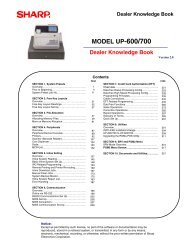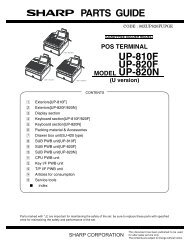ER-A Model - MS Cash Drawer
ER-A Model - MS Cash Drawer
ER-A Model - MS Cash Drawer
Create successful ePaper yourself
Turn your PDF publications into a flip-book with our unique Google optimized e-Paper software.
File Group Types:<br />
<strong>ER</strong>-A <strong>Model</strong> SRV (Service) Mode – File Allocation Overview<br />
• Type 0: (Child) is modified automatically when the parent file group is changed. Create/Erase<br />
only. (e.g.: Department Text, PLU Price, or PLU Stock)<br />
• Type 1: (Parent or Primary) requires a Number of Records Entry. Create/Erase and<br />
Increase/Decrease the number of records. (e.g.: Dept., PLU, or Server/<strong>Cash</strong>ier)<br />
Operational buffers, such as the “Register Buffer”, are also considered to be Primary Files.<br />
Primary Files also include those files opened for report data storage such as Term, Gross Margin,<br />
Daily Net, Hourly, and Transaction. These reports can not be run if the corresponding files are not<br />
allocated.<br />
• Type 2: Requires an Entry of Indexes and Records. Create/Erase and Increase/Decrease the<br />
number of records for label and data individually. (e.g.: GLU/PBLU)<br />
Calculating Memory Usage<br />
Calculating the memory needed for specific applications is very important. This information is needed to<br />
know what RAM options are required. If given a set amount of RAM, it enables you to determine the<br />
maximum number of functions (such as PLUs, and UPCs) that can be installed.<br />
The general formula for calculating the memory required for any particular file is (See Example <strong>ER</strong>-<br />
A520/530 File Table No. Listing):<br />
TN = (NR x NB) x (RL + LS)<br />
Where:<br />
TN = Total Number of bytes.<br />
NR = Number of Records<br />
NB = Number of Blocks<br />
RL = Record Length (Data Size)<br />
LS = Label Size<br />
If the file that is being calculated is allocated is MRS, you should subtract the number of bytes the file<br />
uses at MRS from the value derived by the formula shown above. The result will be the amount of<br />
ADDITIONAL RAM required, or if the file size is being decreased, the amount of RAM freed.<br />
Reminders:<br />
1. The number of bytes in the Label Size must be added to the Record Length in order to get the<br />
actual number of bytes required for each record.<br />
2. If the number of records (or blocks) of a Type 1 (Parent or Primary) file group is changed, the<br />
files that follow the Type 1 (Parent or Primary) file group size will also be changed.<br />
4 OF 14<br />
Page 55 of 108





